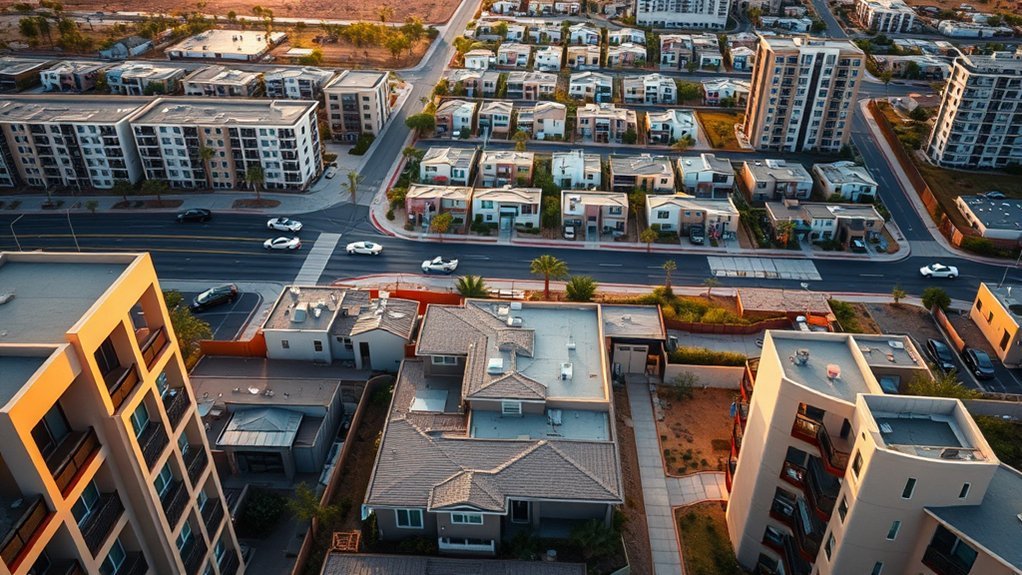If you’re paying $1,095 a month for a one‑bedroom near downtown, you’ll want to see how that fits into a typical Las Vegas budget. You’ll get clear, data‑backed figures on rent, utilities, groceries, and transit costs so you can plan realistically. The city’s overall cost sits slightly below the national average, but specific neighborhoods and commuting needs can change your monthly total considerably — keep going to find the exact numbers.
What Is the Cost of Living in Las Vegas in 2025?

How affordable is Las Vegas in 2025? You’ll find the cost of living index sits about 97.8, roughly 2.0% below the national average, so living expenses are modestly favorable.
Expect average rent for a two-bedroom near $1,828 and median rent for a one-bedroom about $1,095, while the median home sale price runs around $450,000—resulting in a price-to-rent ratio near 25.03 that favors renting for many.
Plan monthly utility costs around $392.50 to cover electricity, water, internet, and phone.
Transportation expenses will likely be significant: roughly $1,322 monthly for a single adult, since most people drive.
When budgeting, prioritize basic necessities, add utilities and transport to rent or mortgage, and compare totals to the cost of living index to see relative affordability.
You can then target affordable neighborhoods and adjust lifestyle choices to meet your financial goals without unexpected shortfalls.
Housing and Rental Prices by Neighborhood

You’ll see clear rent differences across neighborhoods — Mira Villas averages about $2,039 for a one-bedroom and $2,279 for a two-bedroom, while The Section Seven averages $1,273 and $1,444 respectively.
Compare those figures to the citywide averages (one-bedroom $1,095; two-bedroom $1,828) and the average home sale price (~$450,000) to weigh buying vs renting.
Use these numbers to gauge affordability by area and decide whether renting or buying fits your budget and timeline.
Neighborhood Rent Differences
Neighborhood matters when you’re hunting for a place in Las Vegas: citywide averages hide wide swings between neighborhoods, so your choice can change monthly rent by hundreds or even a thousand dollars.
The average monthly rent in Las Vegas is about $1,468, below the national average, but neighborhood-level rent prices vary sharply. You’ll see expensive pockets and affordable options depending on priorities.
- Mira Villas: among the most expensive, one-bedrooms average $2,039 and two-bedrooms $2,279.
- The Section Seven: more affordable, with one-bedrooms around $1,273 and two-bedrooms $1,444.
- Angel Park, Downtown, Lone Mountain: offer competitive pricing for budget-conscious renters.
Use these figures to target neighborhoods that match your budget and lifestyle.
Buying Vs Renting
Having seen how rent swings across areas like Mira Villas and The Section Seven, you’ll want to weigh those neighborhood price differences against the costs of buying.
Use data: average rent for a two-bedroom is about $1,828 and one-bedrooms average $1,095, while renting in Las Vegas overall averages $1,267/month — 22.7% below the national average.
The median home sale price is roughly $450,000, so monthly mortgage payments will create a bigger, longer-term cash outflow than typical rent.
For buying vs renting, compare upfront costs, ongoing housing costs, and how long you’ll stay.
If you need affordable cost and flexible cash flow, renting often wins; if equity and stability matter, buying can support comfortable living in Las Vegas over time.
Affordability by Area
Because prices vary a lot across the city, where you live will strongly determine your housing costs: you’ll see wide differences in Average Rent in Las and Home Prices by neighborhood.
The citywide average rent in Las for a one-bedroom is $1,095 and $1,328 for two-bedrooms, while the average home sale price is about $450,000.
Check these neighborhood contrasts:
- Mira Villas: high-end rent — one-bed $2,039, two-bed $2,279; reflects upscale housing in Las and higher basic services costs.
- The Section Seven: more affordable rent — one-bed $1,273, two-bed $1,444; better for tight budgets.
- Broader market: North Las Vegas starts near $300,000; Summerlin and Henderson span $400k–$1M+, showing clear affordability by area.
Monthly Budget Breakdown: Rent, Utilities, and Groceries

One practical way to plan your monthly budget in Las Vegas is to start with rent, since a one-bedroom averages $1,095 and a two-bedroom $1,828, then add utilities, groceries, and transport to see the full picture. You’ll track average rent and utilities in Las Vegas alongside average grocery expenses to build a realistic monthly budget. For a single adult, utilities for a typical 915 sq ft unit run about $246.66 and groceries average $349. Combine those with transportation costs to gauge single adult expenses. A comfortable monthly budget for one person lands near $4,695 given local living costs in Las Vegas.
| Item | Typical Cost | Notes |
|---|---|---|
| One-bedroom rent | $1,095 | average rent |
| Utilities (monthly) | $246.66 | utilities in Las Vegas |
| Groceries (single) | $349 | average grocery expenses |
Use this table to adjust numbers for your exact situation and finalize your monthly budget.
Transportation, Commuting, and Parking Costs

After you’ve mapped rent, utilities and groceries, factor in transportation — it’s a major monthly line item in Las Vegas. The average annual transportation cost for a single adult is about $15,858, roughly $1,322 per month.
With around 95% of residents commuting by car, gasoline prices (about $4.13 per gallon) and parking amplify costs; public transportation is an option but often infrequent.
- If you ride occasionally, a single public transportation fare is $2.00; frequent riders can buy a 30-day public transit pass for $65.00.
- Driving means budgeting for fuel, parking fees and maintenance; your commuting miles determine how much gasoline prices affect you.
- Compare the $246.66 monthly utility costs for a typical 915-sq-ft apartment against transportation to prioritize spending.
Use these figures to model scenarios: full-time driving, mixed-mode commuting, or relying on a 30-day public transit pass to see which lowers your monthly outlay.
Childcare, Education, and Family Expenses

When you’re budgeting for a family in Las Vegas, childcare and education can quickly become one of your largest monthly expenses: average childcare runs about $13,711 per year for one child (over $1,143/month) and tops $26,784 for two children (about $2,232/month).
You’ll want to plan for those monthly childcare expenses as a baseline in your family expenses spreadsheet and compare local providers. Public K-12 education is free for residents, which helps reduce ongoing costs, but you may still budget for supplies, activities and before/after care.
Private school tuition varies widely—expect roughly $6,000 to $20,000 annually—so factor that if you prefer private education. If you or a family member pursue additional training, community college tuition for in-state students runs about $3,800–$4,200 per year, a relatively affordable option.
Use these figures to model scenarios (one child, two children, public vs private) and prioritize which education-related costs you can adjust to meet your overall budget.
Healthcare, Insurance, and Wellness Costs

Budgeting for childcare and schooling is only part of family expenses—you also need to account for healthcare, insurance, and routine wellness costs that can change your monthly outlay.
In Las Vegas, average healthcare costs are lower than many cities — about $2,814 per year for a single adult and roughly $7,746 for a family of four. A standard doctor visit runs ~$110.44, dental ~$99.25, and optometry ~$100.78, so include routine visits in your monthly budget.
- Factor in insurance premiums and out-of-pocket costs when comparing plans for financial stability.
- For families, combine child care expenses (often $1,143+ per child monthly) with healthcare services to see total living costs.
- Use the healthcare cost index (88.7) to estimate savings versus national averages and adjust your emergency fund.
You’ll see spending varies by needs and choices, so plan conservatively, review plans annually, and prioritize preventive care to limit unexpected expenses.
Taxes, Wages, and How Much You Need to Live Comfortably

Because Nevada doesn’t levy a state income tax, you’ll immediately keep more of your paycheck compared with residents of many other states, but you still need to account for federal taxes, payroll deductions, and local costs when calculating take-home pay. The average hourly wage in Las Vegas is about $25.62, so you should convert hourly pay to annual income to compare against living costs. For a single adult, aim for roughly $56,352 annual income before taxes to cover housing, groceries and essentials. Transportation costs average $1,322 monthly and with ~95% driving, you must budget accordingly for fuel, maintenance, and insurance. For a family of four, the recommended salary is about $104,835 annually; childcare (≈$1,981/month) drives much of that need. Remember Nevada state income tax is zero, but federal tax brackets and payroll deductions still reduce take-home pay. Use the table below to plan and adjust your monthly budget.
| Item | Typical value |
|---|---|
| Average hourly wage | $25.62 |
| Single adult annual income target | $56,352 |
| Family of four annual target | $104,835 |
| Monthly transportation costs | $1,322 |
Entertainment, Fitness, and Lifestyle Expenses

When budgeting for entertainment, plan for a mix of paid nightlife and shows — movie tickets average about $13 and major shows can be much higher.
For fitness, gym memberships generally run $30–$70 per month and many studios offer pay-as-you-go classes if you don’t want a contract.
Balance costs by using free or low-cost outdoor recreation like hiking and Strip attractions to keep your overall lifestyle spending down.
Nightlife and Shows
Nightlife in Las Vegas moves fast and costs add up quickly, so plan for entry fees of about $20–$50 for clubs and $50–$200+ for major shows or concerts depending on seating and performer.
You should budget based on the nightlife and entertainment mix you prefer: club admission is cheaper on weeknights, big-name tickets spike with demand, and drinks run about $10–$15 each.
Factor dining out and the broader culinary scene into nights out—an average mid-range meal for two is about $80.
- Typical club admission: $20–$50, drinks $10–$15 each
- Show tickets: $50–$200+, varies by performer and seating
- Consider monthly gym membership ($30–$50) when balancing lifestyle trade-offs
Gym and Classes
After a night out, many people balance entertainment expenses with fitness costs to keep their budget on track.
You’ll find gym memberships in Las Vegas typically run $30–$70 per month, a predictable line in your monthly budget compared with variable nightlife costs.
If you prefer group fitness classes, expect $15–$30 per session, though package deals lower the per-class price.
Personal training sessions average $50–$100 per hour if you want tailored progress.
Many facilities offer promotional rates for new members, so shop around for affordable fitness options that fit your rent and overall spending plan.
Don’t forget outdoor activities remain a free, cost-effective supplement to paid options when you’re trimming expenses.
Outdoor Recreation
Because Las Vegas sits near Red Rock Canyon and Lake Mead, you’ve got abundant and low-cost options for outdoor recreation that help keep entertainment and fitness expenses down.
You’ll find over 50 parks and multiple hiking trails across the city, so regular fitness and leisure don’t require expensive memberships. Annual costs for outdoor recreation — including occasional gym use and sports leagues — average around $600 per person, a reasonable addition to your budget.
Free or low-cost festivals and outdoor fitness classes further reduce costs while boosting social life. Consider joining community sports teams to combine exercise and networking.
Key low-cost options to use regularly:
- Local parks and hiking trails for cardio and group workouts
- Outdoor fitness classes and festivals
- Community sports teams and volunteer-led events
Frequently Asked Questions
How Much Does It Cost to Live in Las Vegas for a Month?
You’ll pay about $4,696 monthly. Cost breakdown includes housing expenses ($1,095–$1,828), utility bills (~$247), grocery prices (~$349), transportation costs (~$1,322), plus entertainment spending, dining out, and healthcare fees.
How Much Do You Need to Live Comfortably in Las Vegas?
You’ll need about $4,696 monthly to live comfortably—note rent drives costs. Balance cost effective housing, dining expenses, transportation options, entertainment budget, utility bills, healthcare costs, grocery prices, and lifestyle choices to make it work.
How Much Should I Budget for Las Vegas?
You should budget about $4,700 monthly; use a cost breakdown covering housing expenses, utility bills, transportation costs, grocery prices, healthcare expenses, entertainment budget, and a savings plan so you stay practical and data-driven.
How to Afford Living in Vegas?
You can afford living in Vegas by prioritizing budgeting tips: seek affordable housing, diversify income sources, take part time jobs, make lifestyle adjustments, use financial planning, employ cost cutting strategies, and practice disciplined saving techniques to meet expenses.
Conclusion
You can live in Las Vegas on a practical monthly budget by knowing the numbers: about $4,695 total, with $1,095 for a one‑bedroom, $246.66 for utilities, $349 for groceries, and roughly $1,322 for transportation. With wages and taxes in mind, plan for slightly below national average costs but expect variation by neighborhood. Keep a buffer for healthcare, childcare, and entertainment — don’t put all your eggs in one basket when budgeting here.


